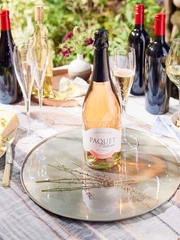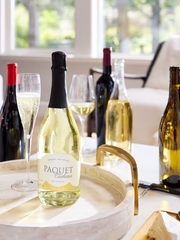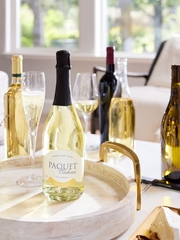 Since 1980, when the first AVA was awarded to Augusta, Missouri, 240 AVAs have been approved for a wide range of winegrowing areas throughout the United States. California has the most with 139 AVAs, 17 of which are located in Sonoma County alone. AVAs range in size from the Upper Mississippi River Valley AVA at 29,900 square miles across four states (Illinois, Iowa, Minnesota, and Wisconsin) to the Cole Ranch AVA in Mendocino County, California, at only 60 acres.
An American Viticultural Area is a designated wine grape-growing region in the United States distinguishable by geographic features, with boundaries defined by the Alcohol and Tobacco Tax and Trade Bureau (TTB) of the United States Department of the Treasury.
Factors like the strength of location and image, climate, geography and history come into play when an AVA is established. To get approval for an AVA, applicants must also show evidence that the proposed AVA is locally or nationally known, provide historic evidence that the boundaries are legitimate and show evidence that growing conditions such as soil and climate are distinctive.
Since 1980, when the first AVA was awarded to Augusta, Missouri, 240 AVAs have been approved for a wide range of winegrowing areas throughout the United States. California has the most with 139 AVAs, 17 of which are located in Sonoma County alone. AVAs range in size from the Upper Mississippi River Valley AVA at 29,900 square miles across four states (Illinois, Iowa, Minnesota, and Wisconsin) to the Cole Ranch AVA in Mendocino County, California, at only 60 acres.
An American Viticultural Area is a designated wine grape-growing region in the United States distinguishable by geographic features, with boundaries defined by the Alcohol and Tobacco Tax and Trade Bureau (TTB) of the United States Department of the Treasury.
Factors like the strength of location and image, climate, geography and history come into play when an AVA is established. To get approval for an AVA, applicants must also show evidence that the proposed AVA is locally or nationally known, provide historic evidence that the boundaries are legitimate and show evidence that growing conditions such as soil and climate are distinctive.
 According to the TTB, all AVAs have equal status under the law. In practice though, wine sales prove that having the Napa Valley or Alexander Valley AVA on a bottle of Cabernet Sauvignon can carry more weight in the consumer's purchasing decision.
Let’s see how other countries are structuring their appellations system.
In Italy, you will find Vini (wines – informally called 'generic' wines'), Vini Varietali (Varietal Wines), Vini IGP (Wines with Protected Geographical Indication) Vini DOP (Wines with Protected Designation of Origin with two sub-categories: Controlled Designation of Origin and Controlled and Guaranteed Designation of Origin).
In 1935, the French government enacted a codified system known as Appellation d’Origine Contrôllée, or AOC, to act as a “controlled designation of origin.” The AOC system carefully regulates such things as vineyard yield, pruning methods, allowable grapes and amount of new oak. French AOC works, in part, because of the long history of growing wine grapes and making wine in France. Trial and error over the generations has shown, for example, that Cabernet grows better in the climate and soils of Bordeaux and Pinot Noir does best in Burgundy.
By comparison, the AVA system places no such restrictions in the vineyard or on the winery. Wine grape-growing and winemaking in the United States has a much shorter history than in France and the diversity of wine regions is spread over a far greater area.
The AVA system is therefore not as rigid or exacting as the French or Italian AOC, on which it is loosely based. New world winemakers want the freedom to experiment with planting different grapes and to practice different winemaking techniques. The complaint with the restrictive AOC system is that rules covering agriculture practices and techniques disrupt the vine’s biological balance, causing the wines to lose their typicity (the degree to which a wine reflects its varietal & signature characteristics of its grape).
According to the TTB, all AVAs have equal status under the law. In practice though, wine sales prove that having the Napa Valley or Alexander Valley AVA on a bottle of Cabernet Sauvignon can carry more weight in the consumer's purchasing decision.
Let’s see how other countries are structuring their appellations system.
In Italy, you will find Vini (wines – informally called 'generic' wines'), Vini Varietali (Varietal Wines), Vini IGP (Wines with Protected Geographical Indication) Vini DOP (Wines with Protected Designation of Origin with two sub-categories: Controlled Designation of Origin and Controlled and Guaranteed Designation of Origin).
In 1935, the French government enacted a codified system known as Appellation d’Origine Contrôllée, or AOC, to act as a “controlled designation of origin.” The AOC system carefully regulates such things as vineyard yield, pruning methods, allowable grapes and amount of new oak. French AOC works, in part, because of the long history of growing wine grapes and making wine in France. Trial and error over the generations has shown, for example, that Cabernet grows better in the climate and soils of Bordeaux and Pinot Noir does best in Burgundy.
By comparison, the AVA system places no such restrictions in the vineyard or on the winery. Wine grape-growing and winemaking in the United States has a much shorter history than in France and the diversity of wine regions is spread over a far greater area.
The AVA system is therefore not as rigid or exacting as the French or Italian AOC, on which it is loosely based. New world winemakers want the freedom to experiment with planting different grapes and to practice different winemaking techniques. The complaint with the restrictive AOC system is that rules covering agriculture practices and techniques disrupt the vine’s biological balance, causing the wines to lose their typicity (the degree to which a wine reflects its varietal & signature characteristics of its grape).
 The takeaway here is that an American Viticultural Area on a bottle of wine is valuable at the time of purchase for any wine buyer. It, however, represents a very small indication of everything else that went into making that bottle of wine. Through our monthly brand releases, we try to provide similar styles year after year and vintage after vintage. Our award-winning wines are designed based on a style and not necessarily or exclusively on the expression of a particular geographic location. This kind of restriction would be detrimental to the integrity of our wine brands.
A recent 2018 winegrowers convention concluded that a new trend is fast growing. Buyers are moving away from wineries listing grape names and AVAs and they gravitate more towards the style and brand of a wine. So get ready for more Lumière de Vie, Joy, Dusk, Somersville, Fleur Bleu and Artisan 5 in the years to come.
The takeaway here is that an American Viticultural Area on a bottle of wine is valuable at the time of purchase for any wine buyer. It, however, represents a very small indication of everything else that went into making that bottle of wine. Through our monthly brand releases, we try to provide similar styles year after year and vintage after vintage. Our award-winning wines are designed based on a style and not necessarily or exclusively on the expression of a particular geographic location. This kind of restriction would be detrimental to the integrity of our wine brands.
A recent 2018 winegrowers convention concluded that a new trend is fast growing. Buyers are moving away from wineries listing grape names and AVAs and they gravitate more towards the style and brand of a wine. So get ready for more Lumière de Vie, Joy, Dusk, Somersville, Fleur Bleu and Artisan 5 in the years to come.





